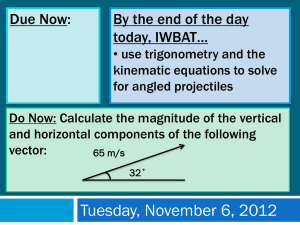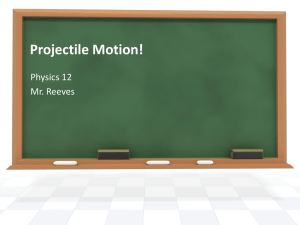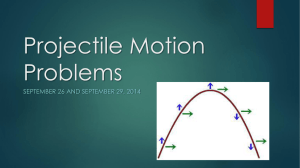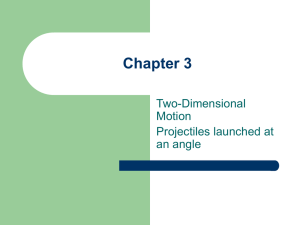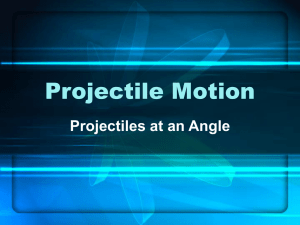Projectile Motion Chapter 3 Section 3
advertisement
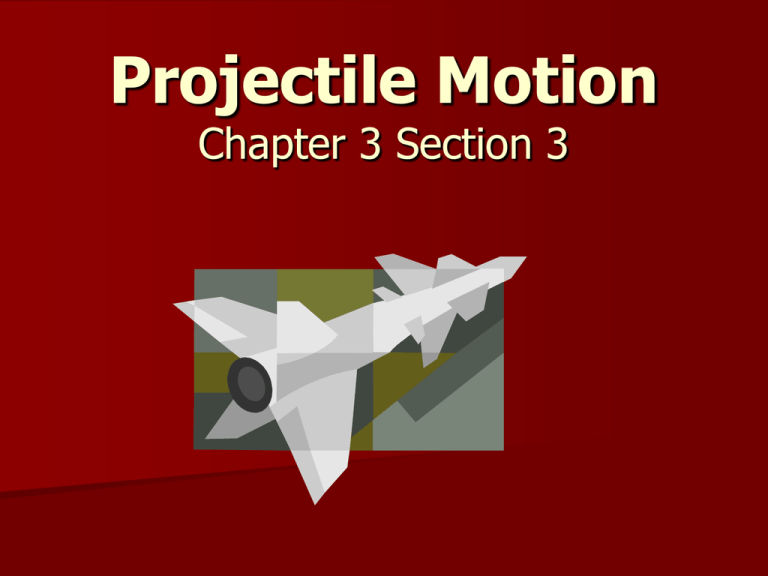
Projectile Motion Chapter 3 Section 3 What is Projectile Motion? Projectile Motion – Motion that is launched into the air that is subject to gravity and described in two dimensions. Examples of projectiles: – – – – – baseballs footballs bullets arrows etc…. How to describe Projectiles Projectile Motion is motion in 2dimensions. When solving for problems dealing with 2dimensional motion, it is best to break the motion into 1-dimensional parts – (Vertical and Horizontal) Once solved in 1-dimensional, recombine the components to find the final resultant. Kinematic Equations The kinematic equations are still used to solve for projectile motion and are applied in one dimension at a time. The setup is the same, but different variables are used to help expression the motion in the x- and y-directions… Kinematic Variable Here is the setup for the variables: 𝑣𝑖𝑥 = 𝑣𝑖𝑦 = 𝑡= 𝑣𝑓𝑦 = 𝑑𝑥 = g= 𝑡= 𝑑𝑦 = Trajectories Objects that are in a projectile motion follow parabolic trajectories – Figure 3-18 pg 99 in book shows a great example… Horizontal Motion of Projectiles Objects that have an initial horizontal velocity retain that velocity as the objects continues in its parabolic trajectory. Example: – If a person runs off a cliff with a velocity of 20m/s, that person will continue to move at 20m/s horizontally as the person falls to the ground below. Horizontal velocity is considered a constant in projectile problems. Vertical Motion of Projectiles As an object is in projectile motion, it continues to have gravity acting on it and falls towards the earth at an acceleration of 9.8m/s² straight downward. Projectile motion is nothing more than free fall with an initial horizontal velocity. – Figure 3-19 pg 99 in book Components of Projectiles Breaking projectile motion in to components can greatly simplify the problem. – Motion can be described in the x-direction and the y-direction. Vix Viy Vi Vector Diagram Viy Vi θ Vix Finding the Components The sine and cosine functions can be used to find the horizontal and vertical components of the initial velocity. 𝑣𝑖𝑥 = 𝑣𝑖 𝑐𝑜𝑠𝜃 𝑣𝑖𝑦 = 𝑣𝑖 𝑠𝑖𝑛𝜃 Projectile Cases There are 3 different cases in which a projectile can be described. – Case 1: Object with only horizontal velocity and no vertical velocity falling with negative vertical displacement. – Case 2: Object that is shot upward at some angle and has both horizontal and vertical velocity and lands with zero vertical displacement. – Case 3: Object that is shot at some angle and has both horizontal and vertical velocity with negative or positive vertical displacement. Kinematic Equations for Case 1 Projectiles Vertical motion of a projectile 1 2 𝑔𝑡 2 𝑑𝑦 = 𝑣𝑓𝑦 = 𝑔𝑡 2 𝑣𝑓𝑦 = 2𝑔𝑑𝑦 Horizontal motion of a projectile 𝑑𝑥 = 𝑣𝑖𝑥 𝑡 𝑣𝑓𝑥 = 𝑣𝑖𝑥 Example Problem #1 A car is traveling at 37.0 km/hr on a perfectly horizontal road when it suddenly loses control and runs off a cliff which is 17.30 meters tall. How far did the car travel before crashing into the ground below the cliff? Example Problem #1 Answer dx = 19.33m Projectiles Launched at an Angle Projectiles are mostly launched at some angle to the horizontal in real-world application. – Examples Bullets Footballs Baseballs The projectile has an initial vertical component of velocity as well as a horizontal component of velocity. Maximum Range To achieve maximum range of a projectile, it should be fired at a 45 degree angle to the horizontal. Case 2 Equations With some algebra and trigonometry, the kinematic equations can be rearranged to solve for certain situations. Special Case 2 Equations 𝑦𝑚𝑎𝑥 𝑣𝑖 𝑠𝑖𝑛𝜃 =− 2𝑔 𝑡𝑟𝑎𝑛𝑔𝑒 2 2𝑣𝑖 𝑠𝑖𝑛𝜃 =− 𝑔 𝑡max ℎ𝑒𝑖𝑔ℎ𝑡 𝑣𝑖 𝑠𝑖𝑛𝜃 =− 𝑔 2 𝑣𝑖 𝑠𝑖𝑛2𝜃 𝑅𝑎𝑛𝑔𝑒 = − 𝑔 Example Problem #2 A quarterback throws a football with a velocity of 27.50m/s at an angle of 35 degrees above the horizontal. a) b) c) d) What is the maximum height? What is the maximum range? How long is the football in the air? What is the impact speed of the football hitting the ground? Example Problem #2 Answer a) b) c) d) 12.69 m 72.52 m 3.22 s 52.42 m/s Kinematic Equations for Projectile Motion Vertical motion of a projectile 1 2 𝑔𝑡 2 𝑑𝑦 = 𝑣𝑖𝑦 𝑡 + 𝑣𝑓𝑦 = 𝑣𝑖𝑦 + 𝑔𝑡 𝑣𝑓𝑦 2 = 𝑣𝑖𝑦 2 + 2𝑔𝑑𝑦 Horizontal motion of a projectile 𝑑𝑥 = 𝑣𝑖𝑥 𝑡 𝑣𝑓𝑥 = 𝑣𝑖𝑥 Impact Velocity and Speed The velocity, or speed, as an object strikes the ground is a combination of Vfx and Vfy. 𝐼𝑚𝑝𝑎𝑐𝑡 𝑆𝑝𝑒𝑒𝑑 = 𝑣𝑓𝑥 2 + 𝑣𝑓𝑦 2 𝑉𝑒𝑙𝑜𝑐𝑖𝑡𝑦 𝐷𝑖𝑟𝑒𝑐𝑡𝑖𝑜𝑛 = tan −1 𝑣𝑓𝑦 𝑣𝑓𝑥 Example Problem #3 A person throws a ball with a velocity of 23.40 m/s at 55 degrees above the horizontal to a friend on top of a small building, which is 21.70 m tall. If the person is standing 24.0 meters away from the building on the ground, will the ball make it over the top of the building and onto the roof? Example Problem #3 Answer No, the ball does not make it to the top of the roof. The ball only goes 18.61m high and the building is 21.70m tall. Example Problem #4 In a scene in a action movie, a stuntman jumps from the top of one building to the top of another building 4.0m away. After a running start, he leaps at an angle of 15º with respect to the flat floor while traveling at a speed of 5.0m/s. Will he make it to the other roof, which is 2.5m shorter than the building he jumps from? Example Problem #4 Answer 4.13 m jump across the buildings Yes, he makes the jump.



